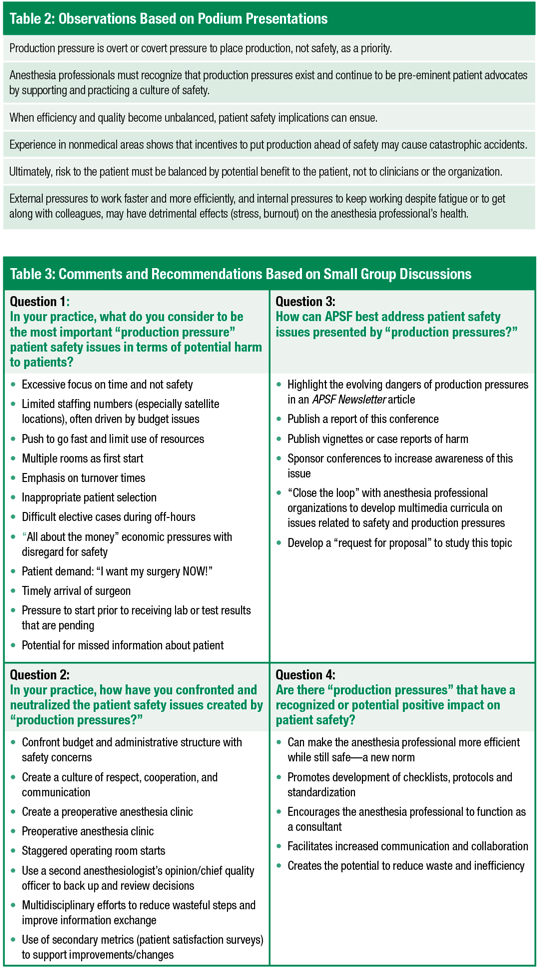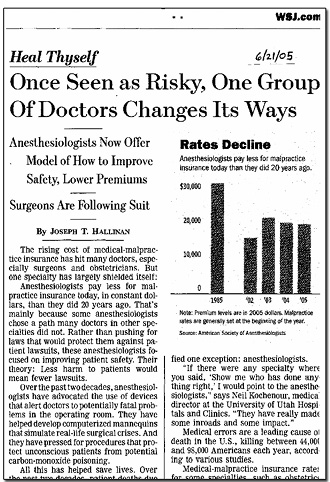On September 8, 2016, the Anesthesia Patient Safety Foundation (APSF) invited representatives of large anesthesia groups and practice management companies to meet with members of the APSF Executive Committee to discuss the patient safety implications of production pressures.
Thirty-five attendees representing 24 large anesthesia groups or practice management companies participated in the half-day session (Table 1). These 24 entities represented a wide geographical cross-section of the United States and a variety of practice models that included all categories of anesthesia professionals. The American Society of Anesthesiologists (ASA), American Association of Nurse Anesthetists (AANA), and American Academy of Anesthesiologist Assistants (AAAA) were also represented.
| Table 1: Large Anesthesia Groups and Practice Management Companies Represented | |
| Jimena Garcia | Baxter Healthcare |
| Timothy Vanderveen, PharmD | Becton-Dickinson |
| Ann M. Bilyew | ClearLine MD |
| Dan J. Sirota | Cook Medical |
| David Karchner | Dräger Medical |
| Leslie C. North, RN | Eagle Pharmaceuticals |
| Angie Lindsey | Fresenius Kabi, USA |
| Matti E. Lehtonen | GE Healthcare |
| Steven J. Barker, MD, PhD | Masimo |
| Richard L. Gilbert, MD, MBA | MEDNAX |
| Patricia Reilly, CRNA | Medtronic |
| Rachel A. Hollingshead, RN | Merck |
| Jeffrey M. Corliss | Mindray |
| Kathy Hart | Nihon Kohden America |
| John Di Capua, MD | North American Partners in Anesthesia (NAPA) |
| Joshua L. Lumbley, MD | NorthStar Anesthesia |
| Dustin R. Crumby, RN | Pall Corporation |
| TBD | PharMEDium Services |
| John C. Dalton, MD | PhyMED Healthcare Group |
| Steven R. Sanford, JD | Preferred Physicians Medical Risk Retention Group |
| Diana Gelston | Respiratory Motion |
| Andrew Greenfield, MD | Sheridan Healthcorp |
| Tom Ulseth | Smiths Medical |
| Andrew Levi | Spacelabs |
| Whitney Reynolds | Teleflex |
| Leona England Rice | The Doctors Company Foundation |
| Kristin Bratberg | US Anesthesia Partners |
| Casey D. Blitt, MD | APSF Treasurer |
| Mark A. Warner, MD | APSF President |
As an introduction to the conference, Robert K. Stoelting, MD, APSF president, described the three options that he believes are available for APSF safety recommendations to become “best practices.” One option is for professional associations (ASA, AANA, AAAA) to adopt APSF safety recommendations in the form of policy statements (Practice Advisories) that would be applicable to all association members. A second option is “spreading the word” among individual anesthesia professionals via social media and educational materials (conference reports in the APSF Newsletter, APSF educational videos). A third option for effecting change and the principal reason to involve large anesthesia groups and practice management companies is APSF’s hope that these entities would individually endorse and adopt selected APSF safety recommendations that are relevant to their practices and resources. Dr. Stoelting proposed that “closing the loop” on APSF safety practices” represents an opportunity for large anesthesia groups and practice management companies to embrace relevant anesthesia patient safety initiatives advocated by APSF.
Following these introductory comments, the safety implications of production pressures were discussed with podium presentations by Drs. David M. Gaba, Samuel DeMaria, Mary Ann Vann, Myriam P. Garzon, and Brian J. Cammarata. Common observations from their presentations are summarized in Table 2.
During the final hour of the conference, attendees were divided into small groups to meet with members of the APSF Executive Committee to discuss four questions relevant to patient safety and production pressures. The comments and recommendations from the small groups are summarized in Table 3.


Wall Street Journal Article from June 21, 2005, featured the APSF, along with the ASA, as leading the way to improve patient safety in anesthesia.
As the moderator of the conference and author of this report, I am taking the liberty of expressing a personal editorial viewpoint based on the small group comments to Question 4 (Table 3): Are there “production pressures” that have a recognized or potential positive impact on patient safety? As background, a front page article in the June 21, 2005, Wall Street Journal entitled, “Once Seen as Risky, One Group of Doctors Changes Its Ways,” observed, “Rather than pushing for laws that would protect them from patient lawsuits, these anesthesiologists focused on improving patient safety.” Perhaps, anesthesia professionals can turn the “negative knee jerk reaction to production pressures” into a patient safety opportunity by endorsing and following the small group responses to Question 4 (Table 3).
Large anesthesia groups and practice management companies in partnership with APSF have a unique opportunity to pursue our common goal that “no patient shall be harmed by anesthesia.”
Robert K. Stoelting, MD
Immediate Past President, APSF


 Issue PDF
Issue PDF